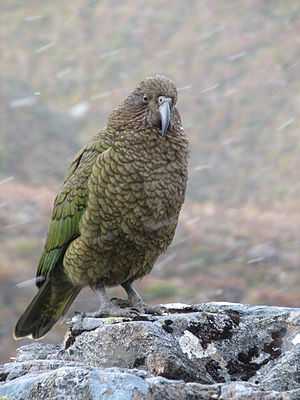Birds of New Zealand

Being an island nation with a history of long isolation and having no land mammals apart from bats, the birds of New Zealand evolved into an avifauna that included a large number of endemic species (that is, species found in no other country). Over the 65 million year isolation from any other land mass New Zealand became a land of birds and when Captain James Cook arrived in the 1770s he noted that the bird song was deafening. Māori and European settlement has been the cause of a huge decline in the numbers of birds and the extinction of over 40% of the 115 or more endemic species.
History after human settlement
New Zealand birds were, until the arrival of the first humans, an extraordinarily diverse range of specialised birds. In New Zealand, the ecological niches normally occupied by mammals as different as rodents, kangaroos and moles, were filled by reptiles, insects, or birds. The only terrestrial mammals were three species of bat (of which two survive today).
When humans arrived in New Zealand about 700 years ago this unique and unusual ecology became endangered. Several species were hunted to extinction, most notably the moa and harpagornis. The most damage however was caused by habitat destruction and the other animals humans brought with them, particularly rats (the Polynesian rat or kiore introduced by Māori and the brown rat and black rat subsequently introduced by Europeans), but also mice, dogs, cats, stoats, weasels, pigs, goats, deer, hedgehogs, and Australian possums. The flightless birds were in particular danger. Consequently many bird species became extinct, and others remain critically endangered. Several species are now confined only to offshore islands, or to fenced "ecological islands" from which predators have been eliminated. New Zealand is today a world leader in the techniques required to bring severely endangered species back from the brink of extinction.
During the early years of European settlement many bird species were introduced for both sport and for a connection with the settler's homelands. New Zealand had a starkly different appearance to the countries from where the settlers came.
Comparison to global bird fauna
The terrestrial birds, wetland birds and seabirds in New Zealand each make up about a third of the total number of species. This is in sharp contrast to the composition of the global bird species where 90% are terrestrial.[1]
When humans first arrived in New Zealand, there were at least 131 species of land, freshwater and coastal birds, and another 65 species of seabirds (gulls, albatrosses, petrels and penguins), making at least 196 native species in total, according to a 1997 report (this count may have risen since as subspecies have been reclassified as species). Of the 131 species that lived on or near land, 93 (or 71%) were endemic, and of the 65 seabirds, 22 (or 34%) were endemic, making 115 (or 59%) endemic species in total.[2]
Conservation
Due to habitat loss, their historical use as a food source by Māori, and predation by introduced species, many birds have become extinct and numerous more are threatened with extinction. Huge conservation efforts are being made to save the takahe, kakapo, mohua, kokako and the kiwi. One well documented conservation success story, due in a large part to the efforts of Don Merton, is the saving of the black robin on the Chatham Islands.
From human settlement to 1994, 43 (or 46%) of the 93 endemic land, freshwater and coastal species have become extinct, as have 4 of the 22 endemic seabird species (making 41% of all endemic species extinct), according to a 1997 report.[2] Fifteen species extinctions have occurred since 1840[3] (this count will have risen to 16 when the North Island snipe was raised from subspecies to species level). According to the 2005 New Zealand Threat Classification System list, 153 species or subspecies were then threatened with extinction.[3]
List of birds of New Zealand
Some of the more well known and distinctive bird species in New Zealand are the kiwi, tui, bellbird and the now extinct moa species.
See also
- Biodiversity of New Zealand
- Endemic birds of New Zealand
- Ornithological Society of New Zealand
- Parrots of New Zealand
- Royal Forest and Bird Protection Society of New Zealand
- Stoats in New Zealand
References
- ↑ Wilson, Kerry-Jayne (2004). Flight of the Huia: Ecology and Conservation of New Zealand's Frogs, Reptiles, Birds and Mammals. Christchurch, NZ: Canterbury University Press. ISBN 0-908812-52-3.
- ↑ 2.0 2.1 Taylor, Rowan et al. (1997). The State of New Zealand's Environment 1997. Wellington, NZ: Ministry for the Environment. p. 115-16 of ch 9. ISBN 0-478-09000-5.
- ↑ 3.0 3.1 Hitchmough, Rodney Arthur; Bull, Leigh; Cromarty, Pam (2007). New Zealand Threat Classification System Lists, 2005. Wellington, NZ: Science & Technical Pub., Department of Conservation. pp. 13, 26. ISBN 0-478-14128-9.
Further reading
- Heather, Barrie; Robertson, Hugh (2005). The Field Guide to the Birds of New Zealand (revised ed.). ISBN 0143020404.
- Morris, Rod; Smith, Hal (1998). Saving New Zealand's Endangered Birds. ISBN 1-86941-249-4.
- Tennyson, Alan; Martinson, Paul (2006). Extinct Birds of New Zealand. Wellington, NZ: Te Papa Press. ISBN 0-909010-21-8.
- Ericson P, Christidis L, Cooper, A, Irestedt M, Jackson J, Johansson US, Norman JA. (2002). "A Gondwanan origin of passerine birds supported by DNA sequences of the endemic New Zealand wrens". Proc Biol Sci. 269 (1488): 235-41.
External links
- Natural Heritage Collection - Comprehensive collection of New Zealand bird photographs. Free for non profit school use.
- Native Birds and Bats - resource in Te Ara the Encyclopedia of New Zealand
- Birds of Christchurch and Canterbury